Abstract
The lighting design of a road tunnel focuses on the setting of pavement luminance. As for the tunnel sidewall luminance, it simply follows the principle of no less than 60% of the pavement luminance. In fact, the sidewall is one of the important components of the tunnel lighting environment; however, the impact of the improvement of sidewall brightness on the LED lighting environment in a tunnel has not attracted enough attention. In this study, the impact of the improvement of tunnel sidewall brightness on the lighting environment and visual characteristics of human eyes were analyzed based on the lighting experiments when the tunnel sidewalls were decorated with two different types of materials and illuminated by LED lamps with five different color temperatures. The test results show that the tunnel sidewall luminance will increase if the energy-storage and luminescent coating with high reflectance is decorated on tunnel sidewalls, and the pavement luminance increases with the increasing sidewall luminance. After the improvement of the sidewall and pavement luminance, the visible distance for a small object in the tunnel will increase to a certain extent. Furthermore, there is no discomfort for drivers during driving, and the changing of eye pupil diameter is relatively stable, which indicates that the increase in tunnel sidewall luminance has a positive effect on the visual performance of drivers.
1. Introduction
Road tunnel lighting systems consume a lot of energy, and the power consumption of 24 h continuous lighting in tunnels has become a heavy burden during tunnel operation [1,2,3]. According to the statistics, the power consumption of tunnel lighting accounts for more than 50% of the total energy consumption for a tunnel [4,5,6]. In China, there were 21,316 road tunnels with a total length of 21,999 km by the end of 2020, and the total length of road tunnels still increases at a rate of more than 10% each year [7,8]. With the continuous growth of total road tunnel length, tunnel lighting faces a serious problem of energy consumption [9,10].
In recent years, LED lamps have become the first choice for tunnel energy-saving lighting [11,12,13]. Fruitful studies have been performed covering the energy-saving effects and layout optimization of LED lamps in tunnels. Sato and Hagio [14] and Renzler et al. [15] investigated the influence of lamp layout on lighting energy saving in road tunnels for the symmetric lighting, counter-beam lighting and pro-beam lighting situations. Fan and Yang [16] established a parameter optimization model to acquire the most energy-saving luminaire installation parameters including luminaire installation height and angle, longitudinal and transverse installation spacing, and luminaire power in the interior zone of road tunnels. Shi et al. [17] analyzed the road surface illumination and evenness obtained from different lighting simulations based on DIALux software to get the best scheme for tunnel lamp installation. Domenichini et al. [18] revealed the influence of the lighting system on the driver’s behavior in road tunnels by means of driving simulator experiments. Zhang et al. [19], Zhao et al. [20] and He et al. [21] studied the effects of the spatial distribution of lighting environment parameters on drivers’ visual performance. Li et al. [22] proposed an optimal design model for determining light sources, powers, layout modes and equipment spacing of lamps in tunnels, which can not only effectively reduce the overall installation and operation cost, but also ease the complexity of manual calculations during the design process of tunnel lighting systems.
The use of LED lighting can save energy consumption on the basis of ensuring the tunnel lighting requirements, and the existing statistical data show that the application of LED lamps in the tunnel can achieve energy saving of more than 30% compared with other types of illumination lamps [23,24,25]. For the LED lighting environment, the lighting specifications of the “Guide for the Lighting of Road Tunnels and Underpasses (CIE 88 2004)” [26] and “Guidelines for Design of Lighting of Highway Tunnels (JTG/T D70/2-01-2014)” [27] specify the road surface luminance in tunnels and demand that the average luminance of the tunnel sidewalls, up to at least a height of 2 m, must be at least 60% of the average road surface luminance at the relevant location. In the existing tunnel lighting design, the lighting calculation and analysis focus on the setting of road surface luminance. As for the sidewall luminance, it simply follows the principle of no less than 60% of the road luminance. In fact, the tunnel sidewall is one of the important components in tunnel lighting environment; however, the impact of the improvement of sidewall brightness on the LED lighting environment in the tunnel has not attracted enough attention. For example, when the sidewall luminance is 80% of the road surface luminance, or even greater than the road luminance, what impact will it have on the lighting environment in the tunnel and the visual characteristics of human eyes? In this study, experimental research was carried out in a tunnel when the tunnel sidewalls were decorated with two different types of materials and illuminated by LED lamps with five different color temperatures, to analyze the impact of improvement of tunnel sidewall brightness on the lighting environment and visual characteristics of human eyes.
2. Test Arrangement
2.1. Tunnel and LED Lamps
The test tunnel is 160 m long, with a clear width of 10.4 m, a clear height of 7.5 m and a wall thickness of 0.25 m. The cross-section dimensions are shown in Figure 1. In the area of 4.6–5.4 m away from the road surface, five rows of LED lamps were installed, and the vertical interval between each row was 0.2 m. In each row, the LED lamps were symmetrically arranged on both sides of the tunnel. The longitudinal interval between two adjacent LED lamps was 10.5 m, and the distance from the first lamp to the tunnel entrance is 12.5 m. The color temperatures of the five rows of lamps from low position to high position are 2500 K, 3500 K, 4500 K, 5500 K and 6500 K, respectively. Two different decorative materials were decorated on both sides of the tunnel sidewalls within the range of 3 m, as shown in Figure 1 and Figure 2. Firstly, the energy-storage and luminescent coating with high reflectance was painted on the tunnel sidewalls, and the indexes of lighting environment and visual characteristics of human eyes in the tunnel were tested. The energy-storage and luminescent coating is a modified rare-earth aluminate material and using energy-storage and luminescent coating for auxiliary lighting in tunnel can increase the brightness because of its high reflection; moreover, the energy-storage and luminescent coating can release the stored energy in the form of light for emergency lighting [28,29]. Then, the energy-storage and luminescent coating was covered with gray cloth, and the same indexes were tested. The appearance and interior decoration of the tunnel decorated with energy-storage and luminescent coating and gray cloth are shown in Figure 2.
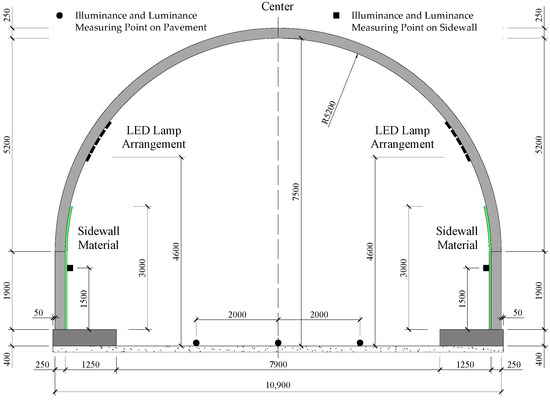
Figure 1.
Dimensions of tunnel cross-section (Unit: mm).
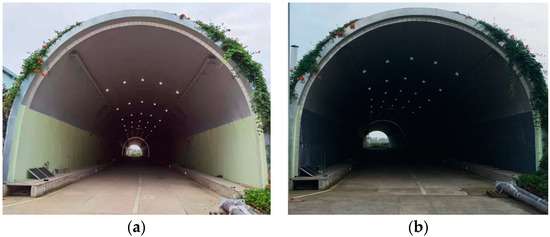
Figure 2.
Tunnel appearance and decoration. (a) Sidewalls with energy-storage and luminescent coating, (b) sidewalls with gray cloth.
2.2. Lighting Environment Setup
The electric power of LED lamps in the tunnel was taken as the control index, and two different electric powers were selected. The luminous efficiency of the LED lamps is 108 lm/W, and the light distribution curve is shown in Figure 3. Combined with the lighting conditions of the test tunnel, two lighting states were set. For the tunnel in which the sidewalls were decorated with energy-storage and luminescent coating, the LED lamps with five different color temperatures were turned on at electric power of 10 W sequentially; then, the LED lamps with five different color temperatures were turned on at electric power of 18 W sequentially, i.e., a total of ten lighting environments. For the tunnel in which the sidewalls were decorated with gray cloth, the power control of LED lamps was the same as that decorated with energy-storage and luminescent coating, which will not be repeated here. The luminance, illuminance, spectral distribution, S/P value and human visual characteristics were tested in the twenty lighting environments to provide a basis for the analysis in this study.
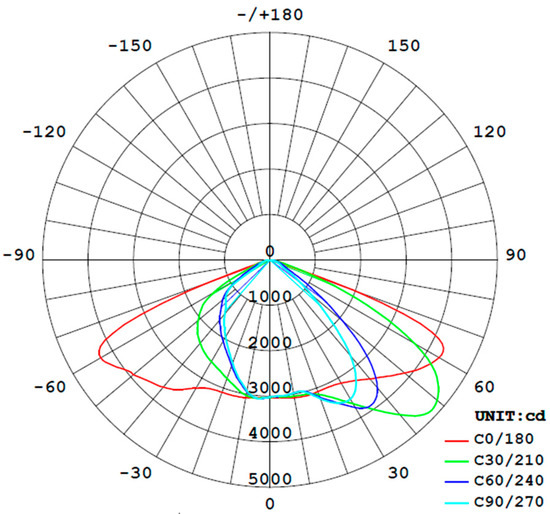
Figure 3.
Light distribution curve of LED lamps.
2.3. Experimental Scheme
After the energy-storage and luminescent coating and gray cloth were decorated on the tunnel sidewalls, the material reflectance was measured to be 0.9 and 0.3 for the coating and cloth, respectively, by the C84-Ш reflectance tester (see Figure 4a). The test was carried out after 8 p.m. to avoid the influence of natural light on the lighting environment in the tunnel. The tested indexes of the lighting environment mainly include the illuminance and luminance in tunnel, and the spectral distribution and S/P value of LED light sources. The illuminance and luminance in tunnel were measured by the CL-500A illuminance meter and LM-3 luminance meter, respectively (see Figure 4b,c), and three cross-section positions of 55 m, 65 m and 75 m away from the tunnel entrance were selected for the measurement. In each cross-section, the measuring points for the illuminance and luminance of road surface were the center of the pavement and the left and right sides which are 2 m from the center (see Figure 1), and there were nine measuring points for the pavement. The sidewall measuring points were at the height of 1.5 m on the left and right sidewalls (see Figure 1) with a total of six measuring points of the three cross-sections. In the testing of sidewall and pavement illuminance, the optical probe of the illuminance meter was along the vertical direction of the sidewall and pavement, respectively. The spectral distribution and S/P value of the LED light sources were measured by the OHSP-350Z multifunctional spectrometer (see Figure 4d), and the measured position was selected at the cross-section of 65 m away from the tunnel entrance.

Figure 4.
Testing devices for lighting environment parameters in tunnel. (a) Reflectance tester, (b) illuminance meter, (c) luminance meter, (d) multifunctional spectrometer.
The test for human visual characteristics includes two parts: the visible distance test for a small object in the tunnel and the dynamic change of the driver’s eye pupil diameter during driving in the tunnel. When testing the visible distance for the small object, three observers with normal sight and without color blindness, color weakness, or other eye diseases stood outside the tunnel with a distance of 38 m away from the tunnel entrance and observed the small object randomly placed in the tunnel, as shown in Figure 5. The small object is a gray cube with a size of 10 cm × 10 cm × 10 cm and a surface reflectivity of 0.2 [19]. The observer firstly stood outside the tunnel and a black cloth was placed in front of him; then, the black cloth was removed, and the observer was requested to recognize the small object randomly placed on the pavement of the tunnel for 0.1 s [19,30]. The observer was asked the following three questions: (1) Is there any object? (2) Where is the position of the object on the pavement? and (3) What is the shape and color of the object? If the three questions were answered correctly, it was considered that the observer can recognize the small object [19]. During the test, the distance between the small object and the observer was repeatedly adjusted until the observer cannot recognize the small object, and then recorded the maximum visible distance between the observer and the small object.

Figure 5.
Visible distance test for a small object in tunnel.
When testing the dynamic change of driver’s eye pupil diameter during driving, one of the three observers who had the longest driving age and was the most skilled at driving was selected as the test object. The Tobii Pro Glasses 3 eye tracker (see Figure 6a), which can realize high-quality eye tracking and ensure accurate and stable eye tracking data, was used. Before the test, the driver parked the vehicle at the entrance of the tunnel, then wore the eye tracker and calibrated it, as shown in Figure 6b. Subsequently, the driver started the vehicle and drove at a constant speed in the tunnel. Driving to the position about 40 m from the tunnel exit, the driver began to brake until the vehicle stopped. Because the test tunnel is only 160 m, the constant speed for the driving was determined as 20 km/h and 40 km/h in the test. During the test, a test assistant sat at the co-driver’s position to be responsible for the data storage of the eye tracker and gave the command to the driver to brake when the vehicle was about 40 m away from the tunnel exit, so as to ensure driving safety (see Figure 6b).
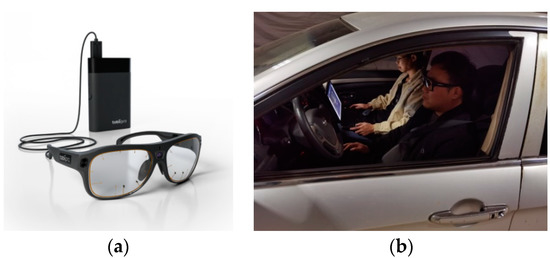
Figure 6.
Acquisition of a driver’s pupil diameter data. (a) Eye tracker, (b) the driver wearing eye tracker.
3. Tunnel Lighting Environment Parameters
3.1. Luminance and Illuminance in Tunnel
The measured luminance and illuminance in tunnel when the sidewalls decorated with energy-storage and luminescent coating and gray cloth are shown in Table 1 and Table 2, respectively. It can be seen from Table 1 that when the LED lamps turned on at the electric power of 10 W, in the tunnel decorated with energy-storage and luminescent coating, the average luminance values of the nine measuring points on pavement corresponding to the LED lamps with color temperatures of 2500 K, 3500 K, 4500 K, 5500 K and 6500 K were 2.7 cd/m2, 2.7 cd/m2, 2.8 cd/m2, 2.7 cd/m2 and 2.9 cd/m2, respectively, and the average luminance values of the six measuring points on sidewalls corresponding to the LED lamps with color temperatures of 2500 K, 3500 K, 4500 K, 5500 K and 6500 K were 3.6 cd/m2, 3.6 cd/m2, 3.8 cd/m2, 3.7 cd/m2 and 3.9 cd/m2, respectively. It can be seen from Table 2 that in the tunnel decorated with gray cloth when the LED lamps turned on at the same power, the average luminance values of the nine measuring points on pavement illuminated by the LED lamps with five different color temperatures were 2.1 cd/m2, 2.2 cd/m2, 2.3 cd/m2, 2.1 cd/m2 and 2.2 cd/m2, and the average luminance values of the six measuring points on sidewalls illuminated by the LED lamps with five different color temperatures were 1.3 cd/m2, 1.3 cd/m2, 1.4 cd/m2, 1.3 cd/m2 and 1.4 cd/m2. For the tunnel illuminated by the LED lamps with five different color temperatures, the luminance and illuminance distribution in the tunnel is basically the same. The luminance and illuminance distribution in tunnel illuminated by the LED lamps with the electric power of 18 W is similar to the above situation and will not be repeated here. As for the relationship between illuminance and luminance of pavement in the tunnel, the lighting specification of “Guidelines for Design of Lighting of Highway Tunnels (JTG/T D70/2-01-2014)” [27] specifies that the conversion relationships between the illuminance and luminance are 10 and 15 on concrete and asphalt pavements, respectively. The pavement of the test tunnel is concrete pavement, and the relationships between pavement illuminance and luminance was 8.4–10.3 (see Table 1 and Table 2). These values were close to the value specified in the specification, which verified the rationality of the test.

Table 1.
Luminance and illuminance in tunnel decorated with energy-storage and luminescent coating.

Table 2.
Luminance and illuminance in tunnel decorated with gray cloth.
Brightness is an important index for the evaluation of tunnel lighting quality. The lighting specifications of “Guide for the Lighting of Road Tunnels and Underpasses (CIE 88 2004)” [26] and “Guidelines for Design of Lighting of Highway Tunnels (JTG/T D70/2-01-2014)” [27] specify that the average luminance of the tunnel sidewalls, up to at least a height of 2 m, must be at least 60% of the average road surface luminance at the relevant location. The ratios of sidewall luminance to pavement luminance in the tunnel decorated with energy-storage and luminescent coating and gray cloth measured in the test were 1.3–1.4 and 0.6–0.7, respectively (see Table 1 and Table 2), which meets the above specification requirements. When the pavement luminance in the tunnel having the sidewalls with gray cloth was in the range of 2.1–2.3 cd/m2, the pavement luminance in the tunnel having the sidewalls with energy-storage and luminescent coating increased by 20–30% on the premise of the electric power of LED lamps keeps unchanged (see Table 1). On the same premise, when the pavement luminance in the tunnel with gray cloth was in the range of 3.4–3.7 cd/m2, the pavement luminance in the tunnel with energy-storage and luminescent coating increased by 40–50% (see Table 2). The application of energy-storage and luminescent coating for auxiliary lighting can increase the brightness in tunnel [28,29]. The tunnel sidewall luminance will increase if the energy-storage and luminescent coating is decorated on tunnel sidewalls, and the road surface luminance increases with the increasing sidewall luminance; however, the increase rate of luminance will be different and needs to be analyzed if the tunnel structural style, lighting system arrangement and other parameters are changed.
3.2. Spectral Distribution of LED Light Sources
The spectral distribution of LED light sources with different color temperatures is shown in Figure 7. According to the spectral distribution in Figure 7, the spectral irradiance of the LED light sources increased with the increasing brightness in the tunnel. The spectral irradiance distribution reflects the radiation energy of light at different wavelengths. When the electric power of LED lamps was the same, the spectral irradiance of the LED light sources in the tunnel decorated with energy-storage and luminescent coating was greater than that decorated with gray cloth. For the LED light sources, the spectrum presented the bimodal distribution characteristics, and there were obvious differences in the bimodal distribution characteristics of LED light sources with different color temperatures. The spectrum with relatively high peak on the left (about 450 nm, see Figure 7c–e) corresponded to high color temperature, and that on the right (between 540 nm and 590 nm, see Figure 7a,b) corresponded to low color temperature. For the LED light sources with low color temperatures of 2500 K and 3500 K, the blue light component with the wavelength of 430–480 nm was less, while the red and yellow light component with the wavelength of 580–780 nm was more. As the color temperature increased to more than 4500 K, the blue light in the range of 430–480 nm gradually increased and the red and yellow light in the range of 580–780 nm gradually decreased.

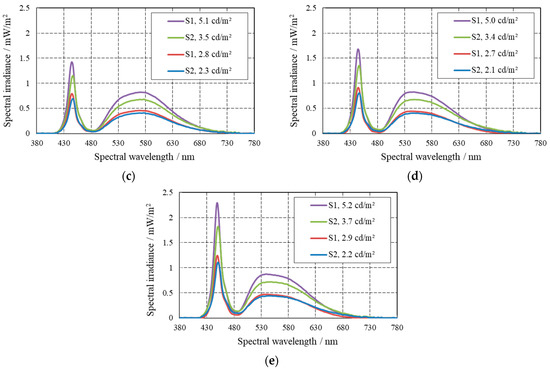
Figure 7.
Spectral distribution of LED light sources (S1 and S2 represent sidewalls with energy-storage and luminescent coating and gray cloth, respectively). (a) 2500 K, (b) 3500 K, (c) 4500 K, (d) 5500 K, (e) 6500 K.
3.3. S/P Value
The S/P value is related to the spectral irradiance distribution of the LED light sources. In general, the S/P value of the LED light sources is ≥1, and the S/P value for LED light sources with more blue light components can be greater than 2 [31]. The S/P values in different lighting environment measured in the test are shown in Table 3. Previous study claimed that in the mesopic vision (between about 0.001 and 3 cd/m2) for human eyes, the higher the S/P value of the LED light source, the driver can feel the lighting with higher brightness under the condition of consuming the same electric energy, and it is beneficial to driving safety in road tunnel lighting [31,32,33].

Table 3.
S/P value.
4. Visual Characteristics of Human Eyes in Tunnel
4.1. Visible Distance for Small Object
Figure 8 shows the comparison of the lighting environment in the tunnel decorated with different materials (energy-storage and luminescent coating and gray cloth) illuminated by LED lamps with different color temperatures (only the situations for electric power of LED lamps of 10 W are listed). The color temperatures of the LED light sources can be divided into warm color (less than 3300 K, and majority of the light is red light), intermediate color (between 3300 K and 5300 K) and cold color (greater than 5300 K, and majority of the light is blue light) [31,32,34]. In general, the tunnel lighting environment was obviously dim when the color temperature was 2500 K, the light was relatively soft when the color temperature was 3500–5500 K, and the lighting environment gave the observers a high cold feeling when the color temperature was 6500 K.

Figure 8.
Comparison of lighting environment in tunnel (from left to right: color temperatures of 2500 K to 6500 K). (a) Sidewalls with energy-storage and luminescent coating, (b) sidewalls with gray cloth.
Figure 9 shows the visible distance for a small object with different color temperatures of LED light sources and pavement luminance (the data in the figure is the average value of three observers’ visible distances). As mentioned in Section 3.3, it is beneficial to driving safety if the S/P value of the LED light source increases in the mesopic vision which is between about 0.001 and 3 cd/m2; however, the data in Figure 9 illustrates that the increase in color temperature and S/P value of LED light had no obvious influence on the visible distance of human eyes. Compared with the color temperature and S/P value, the visibility of a small object was more sensitive to the brightness. The visible distance increased to a certain extent after the luminance of the sidewall and road surface in the tunnel improved by the energy-storage and luminescent coating. For the conditions of single lamp power of 10 W and 18 W, the visible distance of the small object increased by 6–10% and 3–10%, respectively.

Figure 9.
Visible distance for a small object in tunnel (S1 and S2 represent sidewalls with energy-storage and luminescent coating and gray cloth, respectively).
4.2. Dynamic Change of Driver’s Pupil Diameter during Driving
Figure 10 shows the change of the driver’s eye pupil diameter at an interval of 0.5 s while driving in the tunnel with different color temperatures of LED light sources and pavement luminance. The data in Figure 10 shows that for the tunnel with two different sidewalls, the pupil diameter of human eye was basically in the range of 3.8–5.0 mm, and the changing trend was relatively stable when driving in the tunnel at the speed of 20 km/h and 40 km/h. In addition, there was no discomfort for the driver during driving.
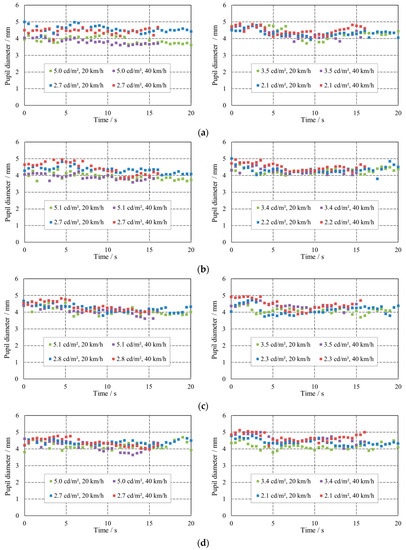
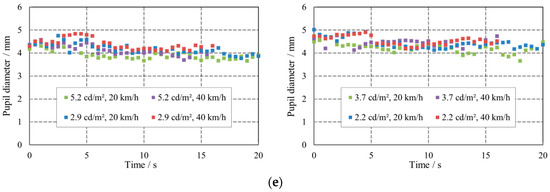
Figure 10.
Driver’s pupil diameter change (left: sidewalls with energy-storage and luminescent coating; right: sidewalls with gray cloth). (a) 2500 K, (b) 3500 K, (c) 4500 K, (d) 5500 K, (e) 6500 K.
Figure 11 shows the change rate of the driver’s eye pupil diameter at an interval of 0.5 s while driving in the tunnel with different color temperatures of LED light sources and pavement luminance. The data shows that for the tunnel with two different sidewalls, the change rate of pupil diameter in 0.5 s interval was −15–15%. Within the range of this change rate, there was no discomfort for the driver. Combined with the distribution characteristics of tunnel luminance in Section 3.1 and the visible distance of the small object in Section 4.1, it can be seen that for LED light sources with different color temperatures, the pavement luminance increased with the increasing sidewall luminance; this improvement increased the driver’s visible distance to a small object in the tunnel to a certain extent, and had no effect on the driver’s pupil diameter change, which indicates that the increase in tunnel sidewall luminance has a positive effect on the visual performance of drivers.
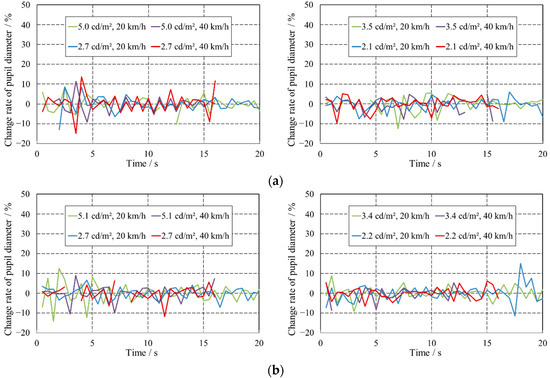
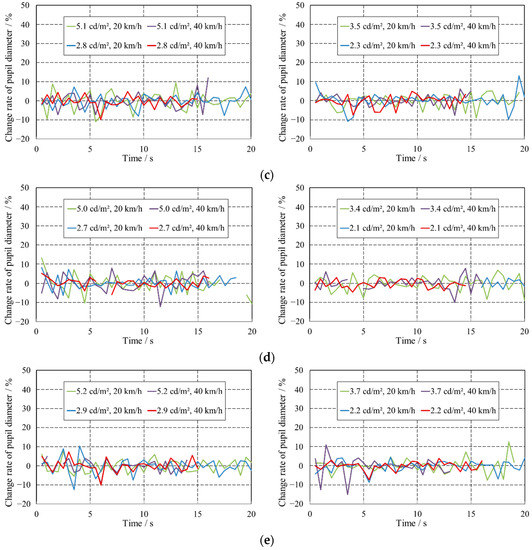
Figure 11.
Change rate of driver’s pupil diameter (left: sidewalls with energy-storage and luminescent coating; right: sidewalls with gray cloth). (a) 2500 K, (b) 3500 K, (c) 4500 K, (d) 5500 K, (e) 6500 K.
5. Conclusions
The impact of the improvement of tunnel sidewall brightness on the lighting environment and visual characteristics of human eyes are analyzed based on the lighting experiments in a tunnel when the tunnel sidewalls are decorated with two different types of materials and illuminated by LED lamps with five different color temperatures. According to the results, the main conclusions are as follows.
The tunnel sidewall luminance increases if the energy-storage and luminescent coating with high reflectance is decorated on tunnel sidewalls, and the pavement luminance increases with the increasing sidewall luminance. Taking the energy-storage and luminescent coating applied in this study as an example, the pavement luminance can be increased by more than 20% compared with the tunnel in which the sidewalls are decorated with gray cloth and illuminated by the LED lamps with the same electric power. In addition, the ratio of sidewall to pavement luminance in the tunnel decorated with energy-storage and luminescent coating is 1.3–1.4, which is far greater than the demand of lighting specifications.
The visibility of human eyes is more sensitive to the brightness than the color temperature and S/P value of the LED light sources. After the improvement of the tunnel sidewall and pavement luminance, the visible distance of a small object in the tunnel will increase to a certain extent. Furthermore, there is no discomfort for drivers during driving, and the changing of eye pupil diameter is relatively stable, which indicates that the increase in tunnel sidewall luminance has a positive effect on the visual performance of drivers; however, the possibility of a glare issue remains to be discussed in a future study.
Author Contributions
Conceptualization, S.F.; methodology, X.C.; validation, J.L.; formal analysis, X.C. and L.Z.; investigation, L.Z. and J.L.; resources, S.F. and H.Z.; data curation, W.M.; writing—original draft preparation, X.C.; writing—review and editing, L.Z.; visualization, L.Z. and J.L.; supervision, W.M.; project administration, H.Z.; funding acquisition, S.F. All authors have read and agreed to the published version of the manuscript.
Funding
This research was funded by the Science and Technology Project of Department of Communications of Guizhou Province, China (No. 2021-122-025), and the Science and Technology Project of Department of Communications of Hebei Province, China (No. TH-201909).
Institutional Review Board Statement
Not applicable.
Informed Consent Statement
Not applicable.
Data Availability Statement
Not applicable.
Conflicts of Interest
The authors declare no conflict of interest.
References
- Gil-Martín, L.M.; Peña-García, A.; Jiménez, A.; Hernández-Montes, E. Study of light-pipes for the use of sunlight in road tunnels: From a scale model to real tunnels. Tunn. Undergr. Space Technol. 2014, 41, 82–87. [Google Scholar] [CrossRef]
- Wang, Y.Q.; Cui, Y.W.; Chen, F.; Ren, R. An “Illumination Moving with the Vehicle” Intelligent Control System of Road Tunnel Lighting. Sustainability 2020, 12, 7314. [Google Scholar] [CrossRef]
- Shen, Y.; Ling, J.X.; Li, T.C.; Zhou, L.; Feng, S.Z.; Zhu, H.H. Diffuse reflection-based lighting calculation model and particle swarm optimization algorithm for road tunnels. Tunn. Undergr. Space Technol. 2022, 124, 104457. [Google Scholar] [CrossRef]
- Moretti, L.; Cantisani, G.; Carrarini, L.; Bezzi, F.; Cherubini, V.; Nicotra, S. Italian Road Tunnels: Economic and Environmental Effects of an On-Going Project to Reduce Lighting Consumption. Sustainability 2019, 11, 4631. [Google Scholar] [CrossRef] [Green Version]
- Sun, D.; Athienitis, A.; D’Avignon, K. Application of semitransparent photovoltaics in transportation infrastructure for energy savings and solar electricity production: Toward novel net-zero energy tunnel design. Prog. Photovolt. Res. Appl. 2019, 27, 1034–1044. [Google Scholar] [CrossRef]
- Qin, L.; Shi, X.H.; Leon, A.S.; Tong, C.D.; Ding, C. Dynamic luminance tuning method for tunnel lighting based on data mining of real-time traffic flow. Build. Environ. 2020, 176, 106844. [Google Scholar] [CrossRef]
- Qin, L.; Peña-García, A.; Leon, A.S.; Yu, J.C. Comparative Study of Energy Savings for Various Control Strategies in the Tunnel Lighting System. Appl. Sci. 2021, 11, 6372. [Google Scholar] [CrossRef]
- Zhou, Z.; Zhang, J.J.; Gong, C.J. Automatic detection method of tunnel lining multi-defects via an enhanced You Only Look Once network. Comput.-Aided Civ. Infrastruct. Eng. 2022, 37, 762–780. [Google Scholar] [CrossRef]
- Qin, L.; Cao, Q.L.; Leon, A.S.; Weng, Y.N.; Shi, X.H. Use of Pupil Area and Fixation Maps to Evaluate Visual Behavior of Drivers inside Tunnels at Different Luminance Levels—A Pilot Study. Appl. Sci. 2021, 11, 5014. [Google Scholar] [CrossRef]
- Shen, Y.; Deng, Y.; Li, T.C.; Zhou, L.; Feng, S.Z.; Zhu, H.H. Determining multidimensional diffuse reflection effects in city tunnel lighting environment. Build. Environ. 2022, 212, 108796. [Google Scholar] [CrossRef]
- Shailesh, K.R.; Tanuja, S.; Kamath, M.V. Analysis of energy savings from replacing HPSV lighting with LED lighting in road lighting application. In Proceedings of the International Conference on Emerging Trends in Electrical Engineering and Energy Management, Chennai, India, 13–15 December 2012; pp. 473–477. [Google Scholar]
- Li, X.J.; Ling, J.X.; Shen, Y.; Lu, T.; Feng, S.Z.; Zhu, H.H. The impact of CCT on driving safety in the normal and accident situation: A VR-based experimental study. Adv. Eng. Inform. 2021, 50, 101379. [Google Scholar] [CrossRef]
- Lee, C.T.; Chen, L.B.; Chu, H.M.; Hsieh, C.J.; Liang, W.C. An Internet of Things (IoT)-Based Master-Slave Regionalized Intelligent LED-Light-Controlling System. Appl. Sci. 2022, 12, 420. [Google Scholar] [CrossRef]
- Sato, M.; Hagio, T. Visibility Enhancement and Power Saving by Pro-beam LED Tunnel Lighting Method. J. Light Vis. Environ. 2014, 38, 89–93. [Google Scholar] [CrossRef] [Green Version]
- Renzler, M.; Reithmaier, N.; Reinhardt, R.; Pohlb, W.; Ußmüllera, T. A road tunnel model for the systematic study of lighting situations. Tunn. Undergr. Space Technol. 2018, 72, 114–119. [Google Scholar] [CrossRef]
- Fan, S.J.; Yang, C. Parameters Optimization and Energy-Saving of Highway Tunnel Stagger Luminaire Distribution Lighting with LED. In Proceedings of the International Conference on Civil, Transportation and Environment, Guangzhou, China, 30–31 January 2016; pp. 436–443. [Google Scholar]
- Shi, N.; Dong, L.L.; Qin, L.; Xu, W.H. Study on lamp-layout scheme of highway tunnel lighting based on DIALux. In Proceedings of the International Conference on Civil, Transportation and Environment, Guangzhou, China, 30–31 January 2016; pp. 773–781. [Google Scholar]
- Domenichini, L.; Torre, F.L.; Vangi, D.; Virga, A.; Branzi, V. Influence of the lighting system on the driver’s behavior in road tunnels: A driving simulator study. J. Transp. Saf. Secur. 2016, 9, 216–238. [Google Scholar] [CrossRef]
- Zhang, X.Q.; Hu, J.B.; Wang, R.H.; Gao, X.J.; He, L.C. The comprehensive efficiency analysis of tunnel lighting based on visual performance. Adv. Mech. Eng. 2017, 9, 1–9. [Google Scholar] [CrossRef] [Green Version]
- Zhao, E.Z.; Dong, L.L.; Chen, Y.; Lou, Q.; Xu, W.H. The Impact of LED Color Rendering on the Dark Adaptation of Human Eyes at Tunnel Entrances. Int. J. Environ. Res. Public Health 2020, 17, 1566. [Google Scholar] [CrossRef] [Green Version]
- He, S.Y.; Liang, B.; Tähkämöb, L.; Maksimainenb, M.; Halonenb, L. The Influences of Tunnel Lighting Environment on Drivers’ Peripheral Visual Performance during Transient Adaptation. Displays 2020, 64, 101964. [Google Scholar] [CrossRef]
- Li, S.G.; Tu, G.; Zhou, Q.H. An optimal design model for tunnel lighting systems. Optik 2021, 226, 165660. [Google Scholar] [CrossRef]
- Sȩdziwy, A.; Kotulski, L. Towards highly energy-efficient roadway lighting. Energies 2016, 9, 263. [Google Scholar] [CrossRef]
- Djuretic, A.; Kostic, M. Actual energy savings when replacing high-pressure sodium with LED luminaires in street lighting. Energy 2018, 157, 367–378. [Google Scholar] [CrossRef]
- Zhao, L.; Qu, S.C.; Zhang, W.G.; Xiong, Z.L. An energy-saving fuzzy control system for highway tunnel lighting. Optik 2019, 180, 419–432. [Google Scholar] [CrossRef]
- CIE. Guide for the Lighting of Road Tunnels and Underpasses (CIE88-2004); Internal Commission on Illumination: Vienna, Austria, 2004. [Google Scholar]
- Ministry of Transport of the People’s Republic of China. Guidelines for Design of Lighting of Highway Tunnels (JTG/T D70/2-01-2014); China Communications Press Co., Ltd.: Beijing, China, 2014. [Google Scholar]
- He, S.Y.; Liang, B.; Pan, G.B.; Wang, F.; Cui, L.L. Influence of dynamic highway tunnel lighting environment on driving safety based on eye movement parameters of the driver. Tunn. Undergr. Space Technol. 2017, 67, 52–60. [Google Scholar] [CrossRef]
- Feng, S.Z.; Chen, X.F.; Mao, W.X.; Zhou, L.; Zhu, H.H. Study on Light Environment in Tunnels Decorating with Multifunctional Energy-storage and Luminescent Material. Chin. J. Undergr. Space Eng. 2021, 17, 2030–2036. [Google Scholar]
- Schreuder, D.A. The Lighting of Vehicular Traffic Tunnels; Centrex Publishing Company: Eindhoven, The Netherlands, 1964. [Google Scholar]
- Ma, F.; Wu, M.J.; Xie, H.B. Lighting of Tunnel; Science Press: Beijing, China, 2018. [Google Scholar]
- Liu, Y.Y.; Peng, L.; Lin, L.Y.; Chen, Z.L.; Weng, J.; Zhang, Q.W. The impact of LED spectrum and correlated color temperature on driving safety in long tunnel lighting. Tunn. Undergr. Space Technol. 2021, 112, 103867. [Google Scholar] [CrossRef]
- CIE. Light as a True Visual Quantity: Principles of Measurement; Bureau Central de la CIE: Paris, France, 1978. [Google Scholar]
- Yang, W.Y.; Jeon, J.Y. Effects of Correlated Colour Temperature of LED Light on Visual Sensation, Perception, and Cognitive Performance in a Classroom Lighting Environment. Sustainability 2020, 12, 4051. [Google Scholar] [CrossRef]
Publisher’s Note: MDPI stays neutral with regard to jurisdictional claims in published maps and institutional affiliations. |
© 2022 by the authors. Licensee MDPI, Basel, Switzerland. This article is an open access article distributed under the terms and conditions of the Creative Commons Attribution (CC BY) license (https://creativecommons.org/licenses/by/4.0/).